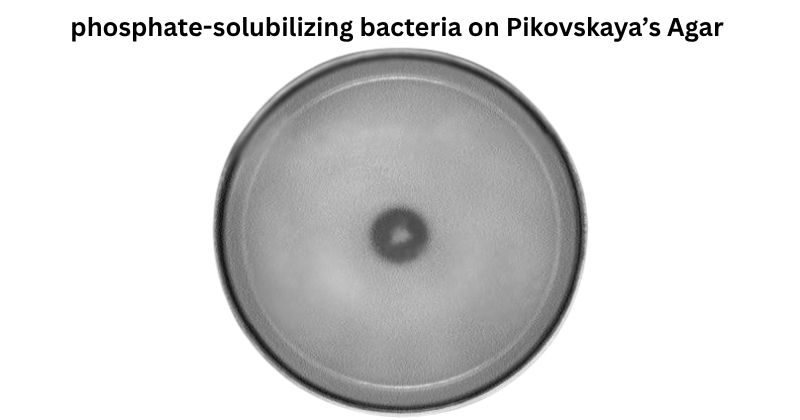Introduction
Pikovskaya’s Agar, also known as PVK medium, is a selective differential medium developed by R.I. Pikovskaya in 1948. This specialized medium is designed to isolate and identify phosphate-solubilizing microorganisms (PSMs)—including both bacteria and fungi—from soil and rhizosphere samples. It is a powerful tool in environmental microbiology, agronomy, and biofertilizer development.
Introduction to Pikovskaya’s Agar
Pikovskaya’s Agar is primarily used for detecting microorganisms that can convert insoluble phosphate (tricalcium phosphate) into bioavailable forms. These microbes play a crucial role in soil fertility and plant nutrition by making phosphorus accessible to plants—a key macronutrient for crop development.
Principle of PVK Medium
Pikovskaya’s agar has insoluble tricalcium phosphate, which microorganisms cannot use. Phosphorus-solubilizing bacteria and fungus produce organic acids (such as gluconic acid and citric acid) and enzymes that reduce the pH and transform insoluble phosphate into soluble forms. This causes a clear halo zone to form around colonies on an otherwise opaque medium. The existence and size of the halo reflect the microorganism’s phosphate-solubilizing effectiveness.

Image Source: ResearchGate
Composition of Pikovskaya’s Agar
| Ingredient | Amount (g/L) | Function |
| Glucose | 10 | Carbon and energy source |
| tricalcium phosphate (Ca₃(PO₄)₂) | 5 | Insoluble phosphate source |
| Ammonium sulfate (NH₄)₂SO₄ | 0.5 | Nitrogen source |
| Sodium chloride (NaCl) | 0.2 | Maintains osmotic balance |
| Magnesium sulfate (MgSO₄·7H₂O) | 0.1 | Cofactor for enzymatic activity |
| Potassium chloride (KCl) | 0.2 | Potassium source |
| Manganese sulfate (MnSO4. H2O) | 0.002 | Micronutrient |
| Ferrous sulfate (FeSO₄·7H₂O) | 0.002 | Micronutrient |
| Yeast extract | 0.5 | Provides B-vitamins, amino acids |
| Agar | 15 | Solidifying agent |
Preparation of Pikovskaya’s Agar
Follow these steps for accurate preparation:
- Dissolve all components (except tricalcium phosphate and agar) in distilled water.
- Add tricalcium phosphate gradually with stirring to form a white suspension.
- Add agar and heat until fully dissolved.
- Adjust pH to 7.0 ± 0.2 using 1N NaOH or HCl.
- Sterilize by using autoclave at 121°C for 15 minutes at 15 psi.
- Pour into sterile petri dishes (cooled to ~45-50°C).
- Allow to solidify; the medium will appear opaque due to suspended phosphate.
Microorganisms on PVK Agar & Colony Appearance
| Bacterium | Type | Colony appearance |
| Bacillus megaterium | Bacterium | White/cream colonies with a clear halo zone |
| Pseudomonas fluorescens | Bacterium | Colonies that are greenish and have a clear halo |
| Aspergillus niger | Fungus | Black colonies with a distinct clear zone |
| Penicillium spp. | Fungus | Green or blue colonies with clear zone |
| Azotobacter chroococcum | Bacterium | Mucoid colonies with a modest phosphate-clearing zone |

Applications of Pikovskaya’s Agar
- Screening phosphate-solubilizing bacteria (PSB) and fungi from environmental samples.
- Isolating efficient strains for biofertilizer production.
- Studying plant-microbe interactions in soil microbiology.
- Exploring the mechanisms of phosphate solubilization.
- Useful in agronomy, environmental science, and biotechnology research.
Precautions When Using PVK Medium
- Tricalcium phosphate is insoluble, therefore shake well before dispensing.
- To avoid contamination, keep sterile surroundings.
- To prevent contamination, handle plates in a clean environment since the media is nutrient-rich.
- Avoid drying out the plates; keep them stored at 4°C.
- Halo zones should only be assessed after appropriate incubation (3–7 days).
Limitations of Pikovskaya’s Agar
- Only measures in vitro phosphate solubilization, which may not correlate with field efficiency.
- Clear zone development is dependent on acid production, and not all methods have been identified.
- Fungi may outgrow bacterial colonies in mixed cultures.
- Some slow growers may not have visible halos in the early phases.
- It does not discriminate between the kinds of organic acids produced.
Conclusion
Pikovskaya’s Agar remains a cornerstone in screening phosphate-solubilizing microorganisms, which are vital for improving soil fertility and sustainable agriculture. While it has limitations, it provides a simple yet powerful method for identifying strains with potential for use in biofertilizers and soil health management.

